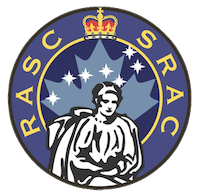Mr. T.S.H. Shearmen, of Brantford, Ontario was elected a corresponding member of the Astronomical and Physical Society of Toronto on 1890-05-06.
No mention can be found of work being carried out at Woodstock College Observatory between 1891 when the previous director left and 1896 when Mr. Shearmen was put in charge, the faculty apparently having no time for astronomical work. Shearmen had been making observations on his own in Brantford and previously had been part of Carpmael's network for the 1882 transit of Venus, observing with a 4-inch refractor in Belleville. Moving to Woodstock in 1896, he worked at the Woodstock Bicycle Co. while he continued the studies he had begun in Brantford. These included observations of the corona of the uneclipsed sun and other solar studies. Variable stars, stellar parallax, the brightness of the outer moons of Uranus and stellar photography were other areas in which Shearmen planned to do research.
At the eighth annual meeting, of 1898-01-06, from Mr. T.S.H. Shearmen a brief report was received of work done at Woodstock and Galt. The 4+1/2-inch equatorial at the latter place, in the observatory of the late Mr. John Goldie, had been in almost constant use for several months past. Observations had been made of coloured, variable and double stars, as also in the examination of planetary detail, and also of occultations by the Moon on all favourable occasions. Mr. Shearmen had made an observation of a partial division in the inner bright ring of Saturn, in July. The original notes in reference to this would be forwarded on completion of some correspondence on the subject with another observatory. In August, Mr. Shearmen and Mr. Alex. McDonald, of Galt, had noted a brilliant meteor, the disappearance of which had been accompanied by a distinctly audible report.
At Woodstock, arrangements had been made for photometric observations of the outer satellite of Uranus. It was finally decided, however, that the 8-inch refractor had not sufficient light-gathering power for delicate work of this kind. Mr. Shearmen had, therefore, commenced the construction of an 18-inch reflector, which was now well on the way to completion. Part of each week had been spent at Brantford, so that the interest in observational work had been maintained at the three different places. Mr. Shearmen was warmly congratulated on his success, and was requested to prepare a paper for the Society on the details of his observations.
At the meeting of 1898-04-14, some notes of observations, etc., were read from Mr. T.S.H. Shearmen of Brantford. Commenting upon the published report of Mr. Lumsden's observation of the "black aurora," Mr. Shearmen stated that he had noted a similar phenomenon on April 7th, 1891, and in his journal had described it substantially as described by Mr. Lumsden on February 27th, 1897. Referring to work on Saturn, Mr. Shearmen stated that since making the observation of a partial division in ring B., he had corresponded with Prof. Schaeberle and had learned that the same observation had been made at Mt. Hamilton. Mr. Shearmen thought it was wrong to credit any observer of the present day with priority in this connection. He considered that the division was the same as observed by Sir William Herschel, but not actually accepted by him as evidence of the occasional multiple character of the rings. Mr. Shearmen reported a conspicuous white spot on the central meridian of Jupiter at 9h. E.S.T. on April 8th, and a number of bright and dark spots near to the central meridian on April 5th at 9h. 28m.
In late May, 1900, Shearman headed south to observe the May 28 total solar eclipse. He set up equipment two miles east of Norfolk, Virginia and was able to make photographs of the event.
In 1901, Mr. Shearman's membership category was changed from 'corresponding' to 'active'. In 1902, he was listed as an associate. His membership was not listed, starting in 1904.
By 1906, Shearmen was to be found in Vancouver, British Columbia, where he became the local meteorological observer and operator of the local time service. He carried out these duties at least into the early 1920's. It was during his stay in the west that Shearmen proposed the ten-foot reflector for Grouse Mountain which he saw as part of a future "chain of international observatories strung like pearls along the summits of the Rockies and Andes Mountains." (Thomson 1978). In 1916 J.S. Plaskett pointed out the impracticality of a ten-foot telescope:
I am afraid he condemns himself by his own words as a dreamer for I do not see how any practical man could talk of mounting a ten foot mirror with wooden appliances.
He called on me last year here and I tried to get some definite information as to how he proposed to cast grind and mount a ten foot mirror but he skilfully evaded the issue and although I believe he is sincere enough I would be very unwilling to invest any money in such an enterprise.

